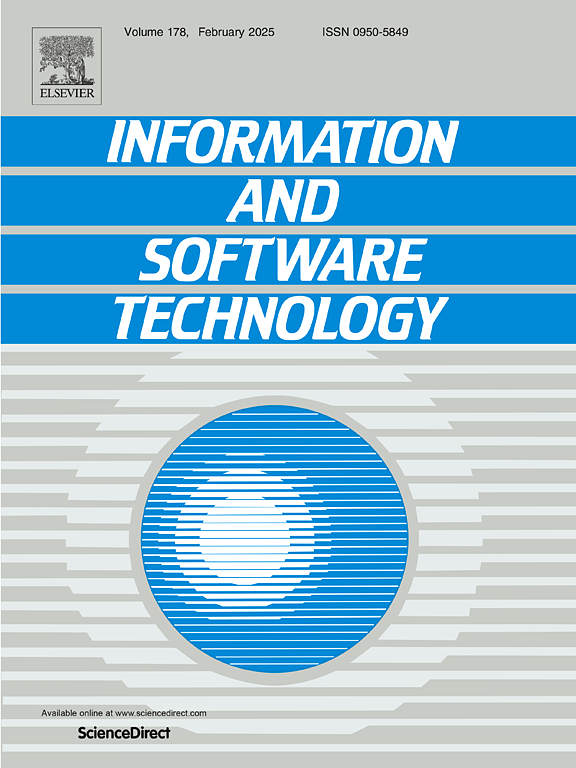Boosting mutation-based fault localization by effectively generating Higher-Order Mutants
IF 3.8
2区 计算机科学
Q2 COMPUTER SCIENCE, INFORMATION SYSTEMS
引用次数: 0
Abstract
Context:
Fault Localization (FL) is an important and tedious phase of software debugging. Among various FL techniques, Mutation-Based Fault Localization (MBFL) demonstrates promising FL accuracy utilizing impact information of statements provided by First-Order-Mutants (FOMs). Despite its success in Single-Fault Scenarios (SFSs), it fails to achieve satisfactory performance in Multiple-Fault Scenarios (MFSs). Higher-Order-Mutants (HOMs) provide a solution for MFSs. However, existing work on HOM generation is inadequate and ignores the correlation among faults in MFSs.
Objective:
In this article, we systematically analyze three relationships among single-faults in MFSs, and further propose three HOM generation methods (i.e., SFClu, SFDis, and SFDen) to simulate different multiple-faults and improve the effectiveness of MBFL in MFSs.
Method:
We investigate the multiple-fault composition on real-world 393 faulty programs from Defects4J, and then apply our methods to generate HOMs for FL. Specifically, SFClu focuses on generating appropriate HOMs for Multi-Single-Source Fault (MSSF) scenarios, where each single-fault is responsible for different observed failures. SFDis is well-suited for Multi-Coupled-Source Fault (MCSF) scenarios where at least two single-faults can interact with each other, leading to certain failures either being observable or masked. SFDen aims to generate suitable HOMs for Single-Coupled-Source Fault (SCSF) scenarios with multiple single-faults that occur within a statement.
Results:
(1) The proportion of MFSs is as high as 63.10% in real-world programs, with MSSF, MCSF , and SCSF scenarios accounting for 35.08%, 53.23%, and 11.69%, respectively. (2) Compared to the best-performing mutant generation method Neural-MBFL, SFClu, SFDis, and SFDen can improve the FL performance for MBFL by 36.78%, 49.80%, and 16.36% in -1, respectively, outperforming eight established SBFL and MBFL techniques. (3) SFClu, SFDis, and SFDen are more suitable for MSSF, MCSF, and SCSF scenarios, respectively, which aligns with their design intend. (4) Their combination further enhances FL accuracy, achieving up to 85 faults successfully localized and an average improvement of 29.54% in -1. Finally, extensive evaluations on SIR with artificial faults and Codeflaws containing student programs demonstrate the generalization of SFClu, the applicability of SFDis on real faults, and the suitability of SFDen for student programs.
Conclusion:
Empirical studies have confirmed the prevalence of MFSs, highlighting the significance of multi-fault localization. Moreover, our proposed three HOM generation methods can further enhance the performance of MBFL with HOMs in MFSs, showing their effectiveness and applicability.
求助全文
约1分钟内获得全文
求助全文
来源期刊

Information and Software Technology
工程技术-计算机:软件工程
CiteScore
9.10
自引率
7.70%
发文量
164
审稿时长
9.6 weeks
期刊介绍:
Information and Software Technology is the international archival journal focusing on research and experience that contributes to the improvement of software development practices. The journal''s scope includes methods and techniques to better engineer software and manage its development. Articles submitted for review should have a clear component of software engineering or address ways to improve the engineering and management of software development. Areas covered by the journal include:
• Software management, quality and metrics,
• Software processes,
• Software architecture, modelling, specification, design and programming
• Functional and non-functional software requirements
• Software testing and verification & validation
• Empirical studies of all aspects of engineering and managing software development
Short Communications is a new section dedicated to short papers addressing new ideas, controversial opinions, "Negative" results and much more. Read the Guide for authors for more information.
The journal encourages and welcomes submissions of systematic literature studies (reviews and maps) within the scope of the journal. Information and Software Technology is the premiere outlet for systematic literature studies in software engineering.
 求助内容:
求助内容: 应助结果提醒方式:
应助结果提醒方式:


